Master Ambient Guitar Effects for Immersive Soundscapes
Category: Guitar Gear
Unlock the Secrets of Ambient Guitar Effects for Soundscapes
If you've landed here, you're likely a guitarist or music producer eager to explore how ambient guitar effects can transform your playing into lush, immersive soundscapes. Maybe you've experimented with pedals or DAW plugins but still feel your textures lack depth or that elusive ethereal quality. Whether you're a seasoned player or an intermediate enthusiast, the quest to master ambient tones is both exciting and complex. This post is crafted to guide you through the essentials — from understanding the key effects like reverb, delay, and modulation, to practical tips on pedal choices and layering techniques. Unlike generic gear lists, here we dive deeply into how each effect shapes your sonic environment and how you can combine them creatively. You'll also discover production insights to enhance your recordings, ensuring your soundscapes captivate listeners and stand out in your compositions. If you're ready to elevate your ambient guitar game beyond basic setups and want actionable advice tailored for real-world playing and production, keep reading. This guide provides clarity and inspiration, so your soundscapes don’t just fill space—they tell a story.
- Unlock the Secrets of Ambient Guitar Effects for Soundscapes
- Understanding Ambient Guitar Soundscapes: Definition, History, and Why They Matter in Modern Music
- Essential Ambient Guitar Effects: Reverb, Delay, and Modulation Uncovered
- Choosing the Right Gear: Pedals, Multi-Effects Units, and Digital Plugins for Ambient Textures
- Setting Up Your Signal Chain for Ambient Sounds: Best Practices for Pedal Order and Layering
- Advanced Effects Techniques: Using Volume Swells, Reverse Delays, Shimmer Reverbs, and Granular Synthesis to Add Dimension
- Playing Techniques that Enhance Ambient Effects: Fingerpicking, Harmonics, E-Bowing, and Dynamic Control
- Incorporating Ambient Effects in Music Production: DAW Setup, Automation, and Mixing Strategies for Lush Guitar Soundscapes
- Popular Ambient Guitar Gear and Artist Inspirations: Signature Pedals and Tone Profiles
- Troubleshooting Common Ambient Effects Issues: Avoiding Muddy Mixes, Noise Problems, and Maintaining Clarity in Dense Effects Stacks
- Creative Exercises and Experimentation Tips: Encouraging Originality and Personalized Sound Development Using Ambient Effects
Understanding Ambient Guitar Soundscapes: Definition, History, and Why They Matter in Modern Music
Ambient guitar soundscapes create immersive, atmospheric textures that go beyond traditional melody and rhythm, transforming the guitar into a powerful tool for sonic storytelling. At its core, an ambient soundscape blends sustained notes, lush reverbs, delays, and subtle modulations to evoke mood and emotion, often blurring the lines between music and environment. This style emphasizes tone and texture over technical virtuosity, allowing the guitarist to sculpt sound layers that fill space and captivate listeners on a sensory level.
A Brief History of Ambient Guitar Soundscapes
The roots of ambient guitar can be traced back to pioneering artists of the 1970s and 1980s who challenged conventional playing. Figures like Brian Eno, often called the father of ambient music, introduced the concept of using the guitar as a sound design instrument, employing tape loops, delay units, and early effects to craft evolving sonic landscapes. Later, guitarists such as Robert Fripp of King Crimson and The Edge from U2 expanded on this ethos with innovative use of delay and reverb, creating signature textures that have profoundly influenced modern ambient music. Over the decades, advances in technology—ranging from multi-effects processors to software plugins—have democratized access to these sounds, making ambient guitar techniques essential for contemporary players striving to evoke atmosphere in genres from post-rock to cinematic scoring.
Why Ambient Guitar Soundscapes Matter Today
In today’s music production landscape, ambient guitar soundscapes remain vital for several reasons:
- Expressive Depth: They add emotional and cinematic layers to compositions, helping guitarists communicate mood and narrative without relying solely on traditional riffs or solos.
- Versatility: Ambient textures seamlessly fit into diverse genres, including indie, electronic, shoegaze, and film music, expanding the guitar’s sonic palette.
- Innovation: Soundscape creation encourages experimentation with effects chains and unconventional playing techniques, fostering creativity in both live and studio settings.
- Listener Engagement: Immersive soundscapes invite listeners into a spatial experience, enhancing the overall impact and memorability of a track.
Embracing ambient guitar soundscapes not only deepens your artistic expression but also aligns your sound with cutting-edge trends in music production, making it a crucial skillset for guitarists and producers aiming to innovate and resonate in the modern musical environment.
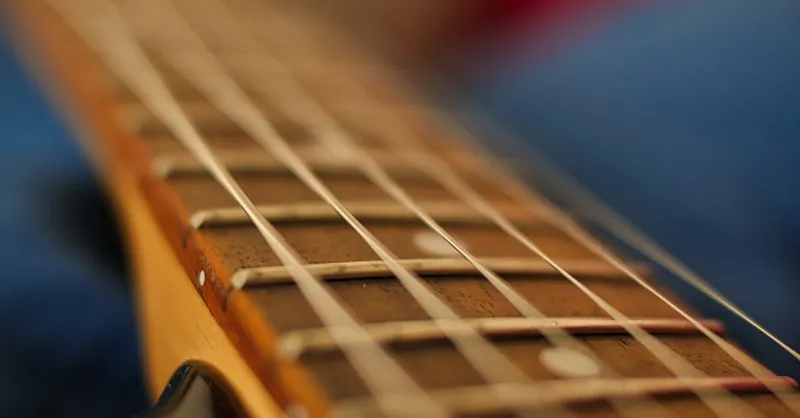
Image courtesy of Sébastien Magnan
Essential Ambient Guitar Effects: Reverb, Delay, and Modulation Uncovered
To truly master ambient guitar soundscapes, an in-depth understanding of the core effects—reverb, delay, and modulation—is crucial. Each of these effects contributes uniquely to building atmosphere, depth, and movement, turning simple guitar lines into expansive auditory environments.
Reverb: Crafting Space and Depth
Reverb is arguably the cornerstone of ambient guitar tone, simulating the natural reflections of sound in physical spaces. By adding reverb, your guitar gains a sense of dimensionality, creating the illusion that the notes resonate in vast halls, cathedrals, or ethereal, undefined realms. Different reverb types—spring, plate, hall, shimmer, and ambient—offer distinct tonal colors and decay characteristics, allowing you to tailor the spatial feel of your soundscapes. For ambient music, longer decay times and subtle pre-delay settings help blend notes smoothly, sustaining the atmosphere without cluttering the mix.
Delay: Echoes That Evolve
Delay effects expand your sonic palette by repeating your guitar signal at timed intervals, generating echoes that add rhythmic and harmonic complexity. In ambient soundscapes, delay isn't just about repetition but about creating evolving, interlaced textures. Techniques like tape delay, digital delay, ping-pong, and multi-tap delay enable you to build cascading layers, where each echo fades into the next, forming shimmering tapestries of sound. Adjusting parameters such as feedback, delay time, and mix level gives you precise control over how dense or sparse your ambient layers become.
Modulation: Adding Movement and Life
While reverb and delay establish space and echo, modulation effects inject motion and subtle dynamic shifts that prevent your ambient textures from feeling static. Common modulation effects that excel in ambient contexts include chorus, flanger, and phaser. These effects gently vary pitch, phase, or amplitude, producing lush, swirling sounds that add emotional depth. For instance, a slow, deep chorus can simulate the trembling of air or water, intensifying the immersive quality of your soundscape. Pairing modulation with reverb or delay layers often results in complex, evolving atmospheres that captivate listeners’ attention.
Bringing It Together: The Role of Effect Chains
Combining reverb, delay, and modulation strategically allows you to craft richly detailed ambient soundscapes. A typical signal chain might start with modulation to shape the tone, followed by delay to construct repeating echoes, and finish with reverb to embed everything in a resonant space. Experimenting with order, mix levels, and parameter tweaks will unlock unique textures tailored to your style. Understanding the sonic roles of these effects empowers you to create immersive guitar atmospheres that not only complement but elevate your compositions and productions.
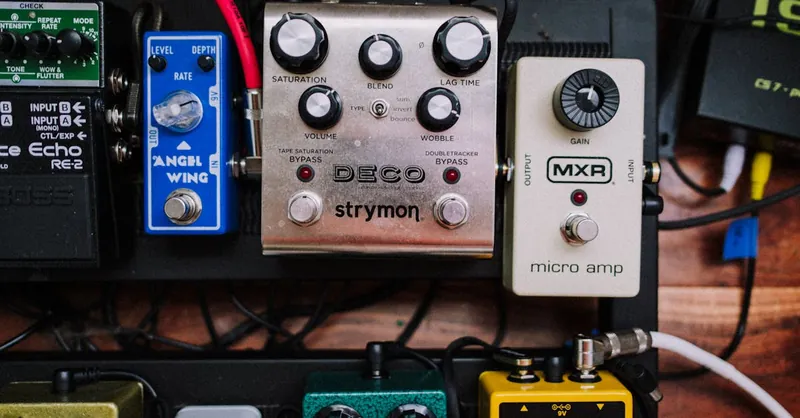
Image courtesy of Kelly
Choosing the Right Gear: Pedals, Multi-Effects Units, and Digital Plugins for Ambient Textures
Selecting the ideal gear is a pivotal step in crafting ambient guitar soundscapes that truly resonate. Whether you prefer the tactile experience of pedals, the versatility of multi-effects units, or the flexibility of digital plugins, each option brings distinct advantages and considerations to shaping your sonic environment.
Pedals: Hands-On Control and Organic Warmth
Standalone ambient effects pedals remain a favorite for guitarists seeking direct interaction and nuanced expression. Popular pedal types for ambient textures include dedicated reverb pedals (like spring, shimmer, and hall reverbs), delay pedals featuring analog or digital repeats, and subtle modulation pedals such as chorus or phaser.
Pros:
- Intuitive, real-time control over parameters via knobs and switches
- Warm, analog-inspired tonal characteristics
- Easy integration into pedalboards with customizable signal chains
Cons:
- Cumulative costs can add up when assembling multiple specialized pedals
- Limited presets compared to digital solutions
- Physical size and cable management may restrict portability and setup simplicity
Multi-Effects Units: Versatility and Preset Flexibility
For players who want a broad palette of ambient effects without purchasing individual pedals, multi-effects processors offer a powerful alternative. Units from brands like Line 6, Boss, and Eventide provide extensive libraries of reverbs, delays, modulations, and even amp simulations, often with the ability to layer and store custom presets.
Pros:
- All-in-one solution with immense effect variety
- User-friendly preset saving and recall for consistent ambient tones
- Compact footprint compared to multiple pedals
Cons:
- Slightly less “organic” feel versus dedicated pedals for some players
- Learning curve in navigating menus and programming chains
- Possible trade-offs in signal fidelity depending on unit quality
Digital Plugins: Infinite Sound Design and Studio Integration
In the realm of music production, digital ambient effect plugins are indispensable for sculpting immersive guitar soundscapes. Software suites like Valhalla DSP reverb, Soundtoys EchoBoy delay, and modulation plugins from Waves or Eventide deliver unparalleled control over spatial effects, allowing fine-tuning of parameters beyond hardware limitations.
Pros:
- Deep customization with advanced controls (EQ, automation, modulation)
- Ability to layer multiple effects without hardware constraints
- Essential for DAW-based recording, mixing, and post-production
Cons:
- Require a DAW and computer setup, limiting live performance use
- Can introduce latency if not optimized
- Less immediate “hands-on” manipulation compared to hardware
Making the Best Choice for Your Ambient Guitar Workflow
Ultimately, the best gear approach hinges on your playing context and creative workflow. If you thrive on tactile expression and live performance, combining quality pedals into a tailored chain is ideal. For those balancing live versatility with studio needs, a multi-effects unit bridges flexibility with ease of use. Meanwhile, producers focused on intricate sound design will benefit most from the endless sculpting capabilities of digital plugins.
By understanding the strengths and trade-offs of each gear category, you can assemble an ambient effects setup that not only complements your style but also enhances your ability to craft captivating ambient guitar soundscapes—whether on stage, in the studio, or both.
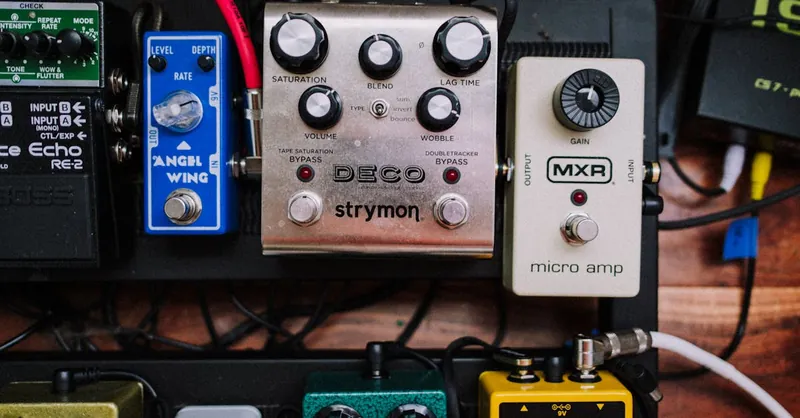
Image courtesy of Kelly
Setting Up Your Signal Chain for Ambient Sounds: Best Practices for Pedal Order and Layering
When crafting immersive ambient guitar soundscapes, the order in which your effects are arranged—your signal chain—plays an essential role in maximizing both the richness and clarity of your tone. Understanding how different pedals interact when chained together can elevate your ambient textures from a simple wash of sound to a nuanced, dynamic sound environment that breathes and evolves.
Optimal Pedal Order to Enhance Ambient Textures
A general rule of thumb for ambient effects is to run modulation effects (chorus, phaser, flanger) first in the chain to maintain clarity and definition of your guitar’s natural tone. Next, follow with your delay pedals, which add repeating echoes that form the backbone of evolving sound layers. Finally, place reverb pedals at the end of your chain, allowing the spacious reflections to envelop all preceding effects, creating a cohesive sense of depth and space.
Here’s a simple, recommended ambient effects chain for starters:
- Guitar → Modulation (Chorus, Phaser, Flanger)
- Delay (Tape, Digital, Multi-Tap)
- Reverb (Hall, Shimmer, Ambient)
This setup ensures that modulation shapes the core guitar signal without being muddied by repeats, while delay creates the cascading loops that reverb then immerses in atmospheric space.
Layering Tips for Clarity and Complexity
- Balancing Mix Levels: Avoid setting all effect mixes to 100%. Opt for subtle mixes on modulation pedals to prevent the tone from becoming overly thick, and moderate delay feedback to keep repeats clear without drowning the dry signal.
- Using Multiple Reverbs Delicately: Experiment with combining different reverb types (like a short plate and a long shimmer) for rich layering, but keep each reverb’s level controlled to maintain tonal clarity.
- Strategic Bypass and Switching: Utilize loop switchers or MIDI controllers to engage different effect combinations during your performance, allowing dynamic shifts in texture and minimizing noise or signal degradation.
Mastering these signal chain best practices ensures your ambient guitar effects work synergistically, preserving note definition while creating expansive, evolving soundscapes. Whether using analog pedals or digital processors, thoughtful ordering and layering unlocks the true potential of your ambient gear setup, ideal for live performance and studio production alike.
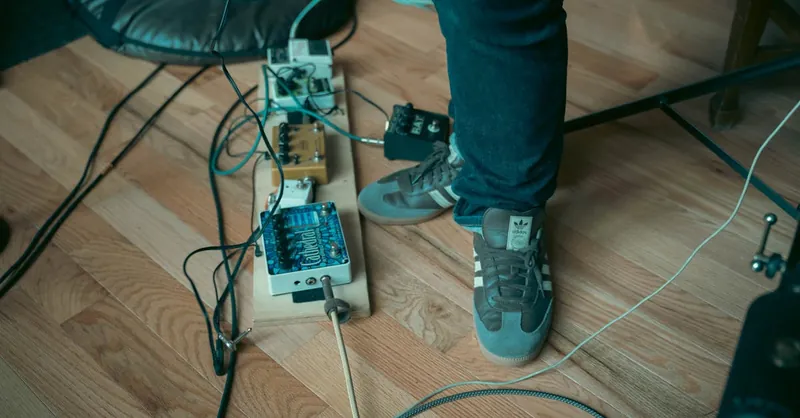
Image courtesy of James Collington
Advanced Effects Techniques: Using Volume Swells, Reverse Delays, Shimmer Reverbs, and Granular Synthesis to Add Dimension
To elevate your ambient guitar soundscapes from lush to otherworldly, incorporating advanced effects techniques such as volume swells, reverse delays, shimmer reverbs, and granular synthesis is key. These methods move beyond traditional reverb and delay to introduce unique textures and dynamic movement that captivate listeners and transform simple guitar tones into expansive, evolving sonic environments.
Volume Swells: Smooth, Vocal-Like Phrasing
Using a volume pedal or volume knob manipulation to create slow fade-ins—known as volume swells—adds an expressive, almost vocal quality to your playing. This technique eliminates the initial attack of the pick or finger, resulting in ethereal, pad-like sounds perfect for ambient layers. Volume swells work exceptionally well when combined with sustained reverb and subtle delay, further blurring note boundaries and adding a sense of infinite sustain. To master swells, control the pedal smoothly and synchronize your picking hand with volume adjustments, crafting seamless transitions that enhance the emotional depth of your soundscapes.
Reverse Delays: Creating Surreal, Time-Bending Echoes
Reverse delay effects invert the traditional repeat, playing echoes backward to create a haunting, rising swell before the original note. This effect imbues your ambient textures with a surreal, hypnotic characteristic often used in cinematic and experimental music. When blended carefully, reverse delay adds an uncanny spatial dimension that pushes your soundscapes into uncharted territory. Experiment with delay time and feedback settings to balance between subtle anticipation and overt psychedelic impact, making sure your reverse echoes complement rather than overpower the composition.
Shimmer Reverbs: Adding a Celestial, Harmonic Layer
A specialized form of ambient reverb, shimmer reverbs introduce octave and harmonic shifts to the reverberated signal, producing bell-like, crystalline overtones. This effect is a staple in ambient and post-rock genres, providing a “glowing” quality that lifts sustained chords and leads into shimmering sonic clouds. Popularized by units like the Eventide H9 and Strymon BigSky, shimmer reverb can be combined with delay and modulation for rich, textured soundscapes that feel both vast and intimate. Adjusting the mix and pitch-shift parameters allows precise control over the shimmer’s intensity and tonal color.
Granular Synthesis: Sculpting Ambient Soundscapes with Micro-Samples
Taking ambient guitar effects into experimental realms, granular synthesis breaks your guitar’s audio into tiny grains, then reassembles and manipulates them in real time. This process enables radical transformations such as time-stretching without pitch change, glitchy textures, and evolving drones. By integrating granular effects via pedals (e.g., Red Panda Particle, Electro-Harmonix Superego) or plugins, you can craft immersive soundscapes with an unprecedented level of detail and unpredictability. Granular synthesis invites exploration and spontaneity, making it an ideal tool for ambient guitarists aiming to push boundaries and create unique, otherworldly atmospheres.
Integrating Advanced Techniques into Your Ambient Arsenal
To incorporate these advanced effects effectively:
- Start Subtly: Layer volume swells or shimmer reverbs gently under your core reverb and delay settings to smoothly expand your sound.
- Experiment with Time-Based Parameters: Fine-tune delay times and feedback levels on reverse delay to sync with song tempo and maintain musical coherence.
- Use Granular Synthesis Sparingly: Its complex textures are most impactful when accentuating specific sections or transitions rather than constant use.
- Combine Techniques Creatively: For example, pair volume swells with shimmer reverb and subtle modulation to develop multidimensional pads that evolve dynamically.
By mastering these advanced ambient guitar effects techniques, you enrich your soundscape’s emotional range and spatial depth—allowing your guitar to transcend its traditional role and become an instrument of immersive sonic artistry.
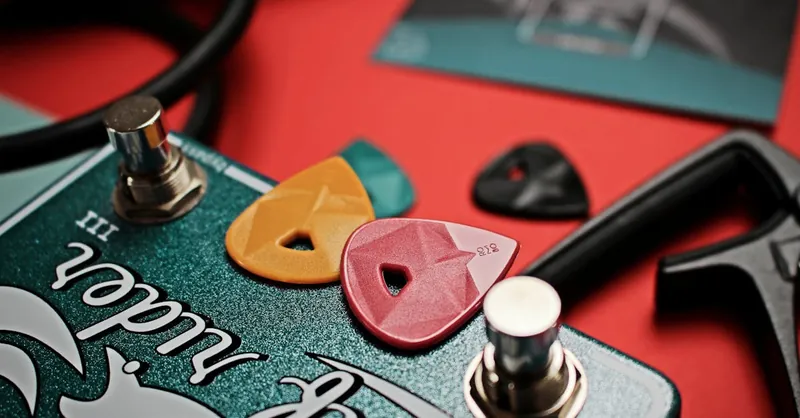
Image courtesy of ROMBO
Playing Techniques that Enhance Ambient Effects: Fingerpicking, Harmonics, E-Bowing, and Dynamic Control
Mastering playing techniques that complement ambient guitar effects is essential for creating rich, immersive soundscapes that breathe and evolve organically. Beyond plugging in pedals and tweaking knobs, how you interact with the guitar strings fundamentally shapes the texture, dynamics, and expressiveness of your ambient tones.
Fingerpicking: Intimacy and Tonal Nuance
Fingerpicking allows precise control over attack, velocity, and note articulation, making it a preferred technique for ambient guitarists. Using fingers instead of a pick softens the attack, enabling smoother transitions between notes that blend seamlessly with reverb and delay tails. Fingerpicking also facilitates complex polyphonic layers and arpeggiated patterns, essential for building evolving soundscapes with depth and subtlety. Try varying finger pressure and plucking angles to extract warm, nuanced tones that respond dynamically to your effects pedals.
Harmonics: Adding Elegance and Otherworldly Texture
Incorporating natural and artificial harmonics introduces shimmering, bell-like tones that enhance the ethereal quality of ambient music. Harmonics ring out with clarity and sustain, making them ideal for creating floating textures that stand out within a dense effects mix. Use harmonics at strategic moments to punctuate your soundscape or layer them under slower reverb swells to generate a celestial resonance. Experiment with pinch harmonics or tapping harmonics combined with delay and shimmer reverb for striking harmonic overtones.
E-Bowing: Infinite Sustain and Fluid Motion
The E-Bow (Electronic Bow) is a powerful tool for ambient guitarists seeking continuous, sustained notes without picking. By magnetically vibrating the strings, it produces a violin-like, smooth tone that dovetails perfectly with ambient effects such as reverb and delay. E-Bowing enables fluid legato lines and drones that can be sculpted dynamically in real time, adding a haunting, cinematic dimension to your soundscapes. Practice controlling your hand position and pressure with the E-Bow to explore dynamic swells, fading drones, and expressive melodic phrasing.
Creative Use of Dynamics: Breathing Life into Soundscapes
Effective ambient playing depends heavily on your dynamic control—the variation in volume and intensity across your performance. Use subtle crescendos, decrescendos, and controlled silences to shape phrases that feel alive and responsive to the evolving effects environment. Coupling dynamic shifts with volume swells from a pedal or your picking hand further enhances the illusion of movement and space within your ambient textures. This interplay between playing intensity and effect parameters creates emotional ebb and flow, preventing ambient layers from becoming stagnant or monotonous.
By integrating these playing techniques—fingerpicking, harmonics, E-Bowing, and conscious dynamic variation—you unlock new expressive possibilities that profoundly enhance your ambient guitar soundscapes. These methods enable you to interact organically with your effects, turning static textures into living, breathing sonic landscapes that engage listeners on a deep emotional level.
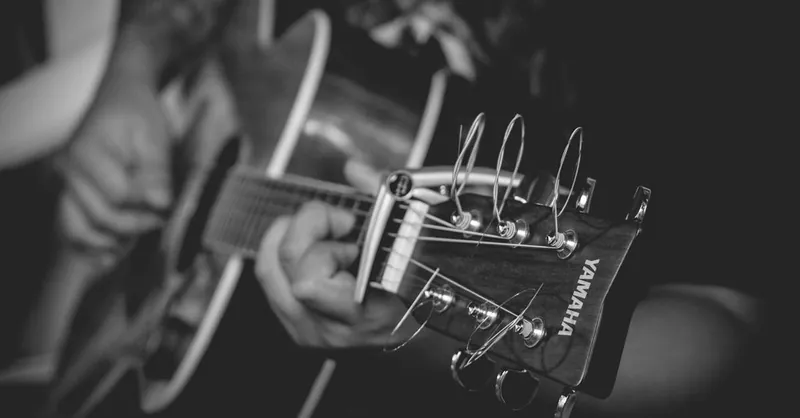
Image courtesy of Harvey Salvador
Incorporating Ambient Effects in Music Production: DAW Setup, Automation, and Mixing Strategies for Lush Guitar Soundscapes
Creating immersive ambient guitar soundscapes in a Digital Audio Workstation (DAW) environment requires thoughtfully integrating effects, employing automation techniques, and applying mixing strategies that preserve clarity while enhancing depth. Unlike live pedal setups, DAWs unlock vast potential for layering and fine-tuning ambient effects with precision, enabling you to sculpt evolving textures that sit perfectly in your mix.
Setting Up Ambient Guitar Effects in Your DAW
Start by recording clean or minimally processed guitar tracks to preserve tonal flexibility. Insert key ambient effects plugins such as reverbs (hall, shimmer), delays (tape, ping-pong), and modulation (chorus, phaser) on separate plugin slots or auxiliary send channels. Using aux sends for time-based effects like reverb and delay is essential because:
- It allows multiple tracks or layers to share the same effect, creating a cohesive sound environment.
- You can independently control the effect’s volume and equalization to prevent muddiness.
- It conserves CPU resources by running a single instance of the effect plugin.
Automating Effects for Dynamic Soundscape Evolution
Automation in your DAW is a powerful tool to bring ambient guitars to life. Use automation envelopes on parameters such as reverb mix levels, delay feedback, modulation depth, and plugin wet/dry balance to introduce subtle shifts and movement across your track. For instance:
- Gradually increasing reverb size during a crescendo can simulate expanding space.
- Automating delay feedback to build echo density during transitions adds tension.
- Modulating chorus rate or depth over time creates evolving textures that keep the listener engaged.
Dynamic automation transforms static ambient layers into organic, breathing soundscapes that react to the composition’s mood and structure.
Mixing Strategies to Preserve Clarity and Enhance Atmosphere
When mixing ambient guitar soundscapes, blending lush effects with the dry guitar signal is crucial for clarity and emotional impact. Consider the following best practices:
- Frequency carving: Use EQ to remove low-end rumble and tame harsh highs from reverbs and delays, helping effects sit in the mix without overshadowing other instruments.
- Parallel processing: Blend heavily effected signals with dry tracks in parallel to maintain articulation while expanding space.
- Use of stereo imaging: Pan delays and modulation effects subtly to widen the soundstage, increasing immersion without tiring the ears.
- Dynamic control: Apply gentle compression on ambient layers to balance peaks and valleys, preserving natural ebb and flow.
Implementing these techniques ensures your ambient guitar textures maintain definition and presence, making your soundscapes not only atmospheric but also musically compelling.
By embracing informed DAW setup, precise automation, and mindful mixing strategies, you can elevate your ambient guitar productions to professional levels—transforming simple playing into rich, evocative soundscapes that capture attention and inspire emotion.
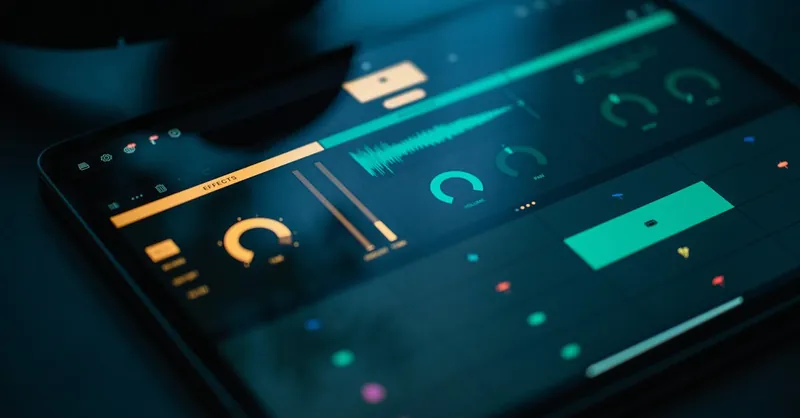
Image courtesy of Egor Komarov
Popular Ambient Guitar Gear and Artist Inspirations: Signature Pedals and Tone Profiles
To truly understand ambient guitar soundscapes, it’s essential to explore the signature gear and tone profiles of pioneering artists who have shaped this sonic landscape. Their choice of pedals and creative use of ambient effects provide invaluable inspiration and practical insights for guitarists seeking to craft lush, immersive textures.
Signature Ambient Pedals That Define Iconic Sounds
Several pedals have become staples in the ambient guitar world, often associated with legendary musicians and revered for their unique contribution to ambient tones:
-
Strymon BigSky Reverb
Renowned for its expansive range of reverbs including shimmer, cloud, and plate, the BigSky offers meticulously crafted algorithms that ambient players favor for creating otherworldly reverberations. Its versatility and pristine sound quality make it a go-to pedal in both studio and live settings. -
Electro-Harmonix Memory Man Delay
A classic analog delay with warm, organic repeats, the Memory Man is beloved by artists like The Edge for its ability to produce rich, textured echoes that form the backbone of evolving ambient soundscapes. -
Boss DD-500 Digital Delay
Offering deep programmability and multiple delay modes, the DD-500 is prized by modern ambient musicians for crafting complex delay patterns and rhythmic loops essential to post-rock and shoegaze atmospheres. -
Eventide H9 Harmonizer
Known for studio-grade effects in a compact unit, the H9 excels at shimmer reverbs, reverse delays, and granular synthesis effects, enabling expressive ambient textures favored by artists pushing experimental boundaries. -
Red Panda Particle
A granular synthesis pedal that allows real-time manipulation of sound grains, it offers unpredictable and richly detailed textural layers ideal for avant-garde ambient compositions.
Artist Inspirations: Ambient Guitar Tone Profiles and Approaches
Studying the gear and signal chains of ambient guitar greats reveals how individual style blends with effects to create signature soundscapes:
-
Brian Eno
Often credited as an ambient music pioneer, Eno’s use of tape delays, looping devices, and custom-built reverb systems laid the foundation for ambient guitar textures. His approach prioritizes atmosphere and generative sound over traditional playing, influencing countless ambient artists. -
The Edge (U2)
Famous for his precise use of delay pedals—especially analog units like the Electro-Harmonix Memory Man—The Edge crafts rhythmic, cascading delay patterns that generate spacious soundscapes while maintaining melodic clarity. -
Robert Fripp
Founder of the “Frippertronics” looping technique, Fripp combines tape delay loops and reverb to build evolving sound layers. His experimental use of effects pedals and e-bowing techniques exemplify the intersection of ambient sound design and expressive guitar playing. -
Jonny Greenwood (Radiohead)
Greenwood’s ambient palette includes modulation-rich delays, shimmer reverbs, and unconventional effect combinations, often enhanced through multi-effects processors and DAW manipulation, showcasing a modern approach to textural guitar soundscapes.
Harnessing These Inspirations for Your Ambient Sound
By integrating these artist-inspired pedals and understanding their tonal philosophies, you can develop your own signature ambient soundscape. Consider:
- Choosing reverb and delay pedals known for their lush, versatile sounds.
- Experimenting with granular and reverse delay effects to emulate evolving textures.
- Analyzing how your favorite ambient guitarists combine effects with playing techniques to add depth and emotion.
Emulating and adapting these gear choices and signature tone profiles not only grounds your ambient guitar work in proven frameworks but also encourages creative innovation, helping you forge immersive soundscapes that captivate and inspire.
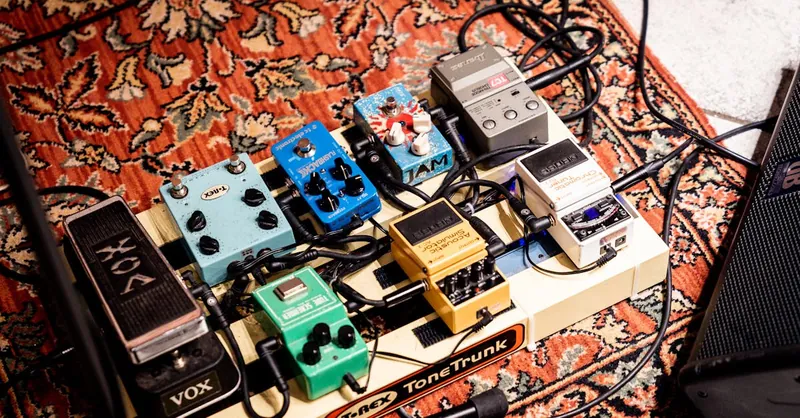
Image courtesy of Rene Terp
Troubleshooting Common Ambient Effects Issues: Avoiding Muddy Mixes, Noise Problems, and Maintaining Clarity in Dense Effects Stacks
Crafting pristine ambient guitar soundscapes is as much about solving sonic challenges as it is about creative experimentation. When layering multiple effects like reverb, delay, and modulation, it’s easy to fall into the trap of muddy mixes, excessive noise, and loss of clarity—issues that can diminish the emotional impact and spatial depth of your sound. Understanding how to troubleshoot these common problems is essential for maintaining transparent, immersive textures that enhance your compositions instead of overwhelming them.
Avoiding Muddy Mixes with Ambient Guitar Effects
One of the most frequent problems in ambient soundscapes is frequency masking, where overlapping effect tails and repeated echoes clutter the low and midrange spectrum. To prevent muddiness:
- Use EQ to carve space: Apply high-pass filters on reverbs and delays to reduce unnecessary low-end buildup, which often booms and muddies the mix. Similarly, gentle cuts in the midrange can eliminate frequency clashes between the dry guitar and your effects layers.
- Control effect mix levels: Keep reverb and delay wet/dry ratios balanced—excessively high wet levels can drown articulation and note definition, especially when combined with modulation effects.
- Opt for shorter decay times on some reverbs: While long tails are desirable in ambient patches, blending multiple reverbs with varying decay lengths helps preserve clarity and prevents a wash of sound that becomes indistinguishable.
Tackling Noise and Excessive Signal Gain
Ambient effects chains involving multiple pedals or plugins can introduce noise and hiss, which becomes particularly noticeable with high gain and long delay feedback settings. To minimize noise issues:
- Manage your signal gain: Avoid pushing the input levels of pedals and interfaces to the point of distortion unless deliberately desired. Using true bypass pedals or noise gate pedals can also help maintain silence during pauses.
- Isolate noisy pedals: Place noise-prone effects like high-gain modulation or analog delays early in the chain and use buffering pedals appropriately to preserve signal integrity.
- Use power supplies with low noise profiles: Isolating power sources and using quality cables further reduce hum and interference, essential for clean ambient textures.
Maintaining Clarity in Dense Effects Stacks
Stacking multiple time-based and modulation effects is a hallmark of ambient guitar, but dense layering risks losing note articulation and dynamic expression. To safeguard sound clarity:
- Layer effects with intention: Combine effects that complement rather than compete—for instance, pairing a subtle chorus with a spacious hall reverb rather than stacking multiple modulation pedals at full intensity.
- Employ parallel processing: Send your guitar signal to parallel effect chains and blend them with the dry track, providing control over how much texture versus clarity you retain.
- Regularly check the mix in mono: Mono compatibility testing helps identify phase issues or frequency clashes caused by overlapping effects, guiding adjustments that enhance stereo field and definition.
By proactively addressing these common problems—muddy frequencies, noise, and loss of clarity—you ensure that your ambient guitar effects stacks remain transparent and expressive. This foundational care in your tone sculpting empowers your soundscapes to stand out with emotional resonance and sonic richness, both live and in the studio.
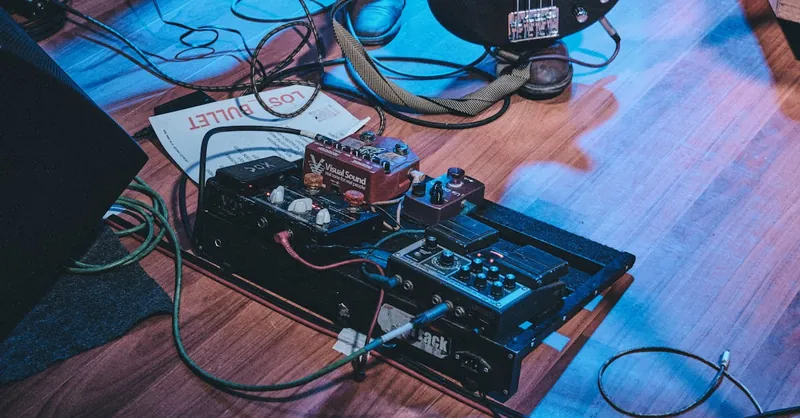
Image courtesy of Marcelo Mora
Creative Exercises and Experimentation Tips: Encouraging Originality and Personalized Sound Development Using Ambient Effects
Exploring ambient guitar effects requires not only technical knowledge but a willingness to experiment and push the boundaries of conventional guitar playing. Developing your own unique ambient soundscape hinges on creative exercises designed to inspire innovation and deepen your connection to your effects setup. Here are actionable tips to guide your personalized sound development using ambient reverb, delay, modulation, and advanced techniques:
Embrace Sound Exploration Through Controlled Experimentation
- Effect Parameter Sweeps: Dedicate practice sessions to slowly adjusting key parameters such as reverb decay time, delay feedback, and modulation rate while playing sustained notes or simple chord progressions. This helps you discover unexpected textures and dynamic shifts that spark new ideas.
- Looping and Layering: Use a looper pedal or DAW looping tools to record short phrases, then layer multiple loops with varying ambient effects on each layer. Experiment with drastically different effect chains per loop to create evolving, polyphonic soundscapes.
- Constraints for Creativity: Limit your effects choices to two or three pedals or plugins and explore maximizing their potential before adding more. This encourages deeper exploration of each effect’s nuances and promotes originality in tone shaping.
- Alternate Tunings and Extended Techniques: Pair ambient effects with alternative guitar tunings, harmonics, or E-Bow usage, as unusual pitch relationships combined with rich effects often yield fresh ambient textures distinct from standard playing styles.
Developing a Signature Ambient Tone: Tips for Authenticity
- Record and Critique: Regularly record your practice and improvisations to identify recurring motifs or textures that speak to your personal style. This feedback loop helps refine your soundscape to one that is truly yours rather than a mere imitation.
- Layer with Intention: Thoughtfully combine effects based on emotional or narrative goals rather than technical possibilities alone. Ask yourself what mood or story your ambient texture should convey, and adjust your effect settings accordingly.
- Experiment with Signal Routing: Break free from traditional linear signal chains by trying parallel effect paths or inserting effects post-DAW recording to reshape raw ambient takes. This non-linear approach often uncovers richer, more immersive atmospheres.
- Incorporate Silence and Space: Use dynamics strategically by incorporating moments of quiet or near silence within your soundscapes. Ambient music thrives on breathing room, and purposeful spaces between sounds enhance listener engagement and emotional impact.
By integrating these creative exercises and experimentation strategies, you will foster originality and craft ambient guitar soundscapes that reflect your unique musical identity. Continuous exploration combined with thoughtful application of ambient effects not only sharpens your skills but also ensures your sound remains fresh, evocative, and deeply personal—a hallmark of truly inspired ambient guitar artistry.

Image courtesy of James Collington
